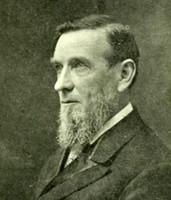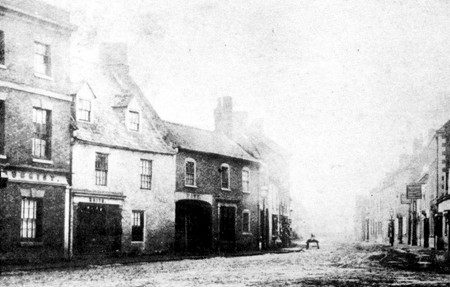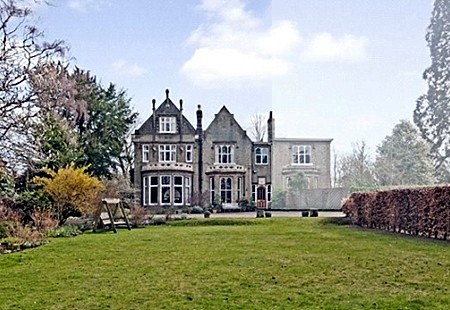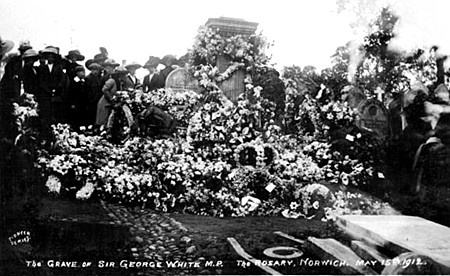|
Sir
George White
1840-1912
|
 |
A cobblers' son who made his mark in
many areas of public life, notably education, religion and the temperance
movement, was born above a shop in Bourne on 13th March 1840 and rose to
become a prominent businessman and Member of Parliament.
He was George White, son of Thomas White, boot and shoe maker, and his
wife, Mary, of West Street, who was educated at the Old Grammar School and
worshipped at the Congregational Chapel [now the United Reformed Church]
in Eastgate, deriving his later interest in both politics and religion
from his father.
On leaving school at 15, George joined his father in the shop but the
following year he left the family business and became a junior clerk at
Tillyard & Howlett at their boot and shoe factory in Norwich for eight
shillings a week. He was industrious and ambitious and anxious to advance
his prospects, spending his spare time on improving his
education with two hours before breakfast each
morning learning mathematics and languages from a local solicitor while in
the evenings taking Greek lessons from his pastor.
At the age of twenty, he was appointed a commercial traveller for the
northern and eastern counties which often proved to be a difficult task
with his colleagues on the road because he had taken the pledge of
abstinence at seventeen and the custom of the time was each to drink what
he liked and the expense to be equally divided among all the
representatives at the table. Young Mr White always refused to drink or to
pay any of the bill and many times the company present tried to exclude
him from the table or, failing that, to serve him with anything yet he
lived to see the custom abolished.
He returned to Norwich to take over the shoe department at the age of 24
and his dedication brought a steady progress through the company until
1875 when he became a partner, later being appointed chairman and managing
director by which time the firm had 2,000 employees and had become the
largest footwear manufacturers in Britain. White was hugely
influential in the efforts of the Norwich shoe manufacturers to convert
shoe making in the city from a cottage industry based on outworking to one
where mass production was the norm.
In 1863 he married Anne (1836-98), daughter of Henry Ransome of Norwich,
and they had seven daughters and a son, George Ernest, who followed his
father in service at Howlett & White, the Norwich Liberal Party and the
Baptist movement.
By this time White had become a leading non-conformist, a member of St
Mary's Baptist Church at Norwich where he also served as deacon and Sunday
school superintendent. On Sunday mornings, he ran an adult school for
bible study and the 250 working men who attended were devoted to him. He
was also an active Sunday school worker for more than half a century and for
several years, he and his wife and their eight children and three servants
would leave the house empty every Sunday afternoon and migrate in a body
to a nearby mission school in which all thirteen of them participated in
the activities of he day.
In 1876 he was elected to Norwich City Council where he specialised in
education. becoming chairman of the Norwich School Board and in 1903, the
George White School was named in his honour. He was also appointed an
alderman and served as Sheriff in
1888.
White was elected as the Liberal member of Parliament for North West Norfolk
in 1900, a seat which he held until his death twelve years later, and
continued to work for social reform and free education for all, his
achievements being acknowledged when he was knighted in 1907 and
in 1910 he was awarded the Freedom of the City of Norwich.
He had begun attending Sunday School in
Bourne at the Congregational School in Eastgate as a lad of four and by
the age of 15 he had become a teacher. But after leaving to pursue his
career in Norwich, he was invited back on two occasions, in 1900, then
Alderman George White, to give the dedication address at the opening of
the new Sunday School building and again in 1911, then Sir Gilbert White,
to attend the celebrations marking completion of extensive alterations to the church
which he opened with a silver key.
Sir George died at his home in Unthank Road, Norwich on Saturday 11th May
1912 after an illness from lung cancer lasting several months. He was
72. The funeral on May 15th was reported to be "one of the most
extraordinary manifestations of sympathy and public interest ever
witnessed in Norwich". Following a private service at his home and a
public memorial service at St Mary's Baptist Church, he was buried at the
Rosary cemetery witnessed by a crowd of some 3,000 gathered on the slopes
around the grave, a remarkable end to a remarkable life.
|
PHOTO ALBUM |
 |
|
The white-washed property with the dormer windows is Thomas White's
shop in West Street (above) where George White was born, photographed
circa 1865 and (below) No 216 Unthank Road, Norwich, the home where he
died in 1912. The bottom picture shows a postcard photograph of his grave at the Rosary
cemetery in Norwich taken soon after the funeral in 1912.
|
 |
 |
|
FROM THE ARCHIVES |
|
THE SHERIFF OF NORWICH ON DRINK, WORK AND
WAGES:
Mr George White, Sheriff of Norwich, who is a native of Bourne, gave
a most interesting address at the Birmingham National Temperance
Congress last week on "Drink traffic and its relation to work and
wages". The speech was full of plain facts and dealt principally
with drink as averse to production. - news item from the Grantham
Journal, Saturday 2nd November 1889. |
See also
Cobbler's son who
became a knight of the realm

Go to:
Main Index Villages
Index
|



